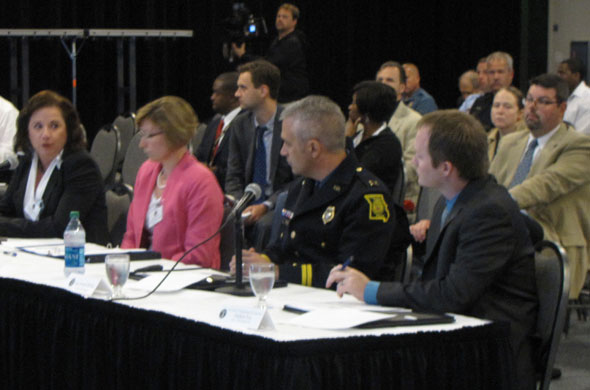
Representatives of NoVA KC including U.S. Attorney Tammy Dickinson, Jackson County Prosecutor Jean Peters Baker; NoVA manager Joe McHale; and UMKC criminology professor Andrew Fox. They made a presentation at the Urban Crime Summit.
By Joe Lambe
Kansas City police will hire four more officers to work one of the highest crime areas in the city, thanks to a $1 million federal grant.
Capt. Joe McHale, project manager of the No Violence Alliance anti-crime effort, said they also will use the three-year grant to study environmental ways to reduce crime.
That can be as simple is not having rock walls by liquor stores, he said, or placing bus stops in better spots.
On Tuesday, McHale and other NoVA leaders also reported on their work to the panel of the urban crime summit being held at UMKC.
The panel put together by Missouri Attorney General Chris Koster is studying ways to reduce violence in Kansas City and St. Louis, cities with some of the highest murder rates in the nation.
The goal of NoVA, which is about a year old, is to reduce the number of murders and shootings by identifying offenders and targeting them for prison or for help.
Jackson County Prosecutor Jean Peters Baker and Tammy Dickinson, U.S. attorney in Kansas City, both NoVA board members, made the presentation with McHale and Andrew Fox, an assistant criminology professor at UMKC.
Fox uses police intelligence and social network analysis, a tool of medicine, to identify the social networks of criminals for NoVA.
He said that 2,100 people in a local network had a murder rate of 500 per 100,000, compared to less than 5 per 100,000 nationwide. He said 24 in the network have already been killed.
Many of them have warrants. Police have already had two sweeps with massive arrests but they are also providing 20 people with services like substance abuse treatment, job hunting help and housing to assist them in abandoning lives of crime.
McHale said the goal is to provide services to 100 by year’s end.
They are also using bullets and shell casing in a federal database to link crimes and those “playing with pistols” in the community, he said.
In another presentation to the justice summit panel, an expert reported similar efforts in other cities.
Amy Crawford, deputy director of the National Network for Safe Communities, said violence intervention aimed at groups of criminals found that violence often comes from poor and often black communities, but only a small percentage of people are violent.
There might be 20 percent of younger age people involved in crime groups but only half of those are actually involved in shootings or serious crime.
Group dynamics drive 80 percent of the violence but it is usually not directly connected to drug dealing, Crawford said.
“It’s about vendettas, it’s about street code, respect.”
Kansas City Police Chief Darryl Forte, who is on the justice summit panel, agreed and said only four of 79 homicides this year have been directly linked to drugs.
Crawford said response to violence on the liberal side has included calls for reducing poverty, racism and oppression and on the conservative side, getting tough on crime.
Neither approach has worked on its own related to gangs or gang violence, she said.
Programs that target groups and warn them the whole group will suffer if one of them shoots or kills someone have been effective, she said.
Police treat offenders with respect – even offer them help – and warn them of certain consequences if they commit violence, she said. “It gives groups a way to stand down.”



Trackbacks